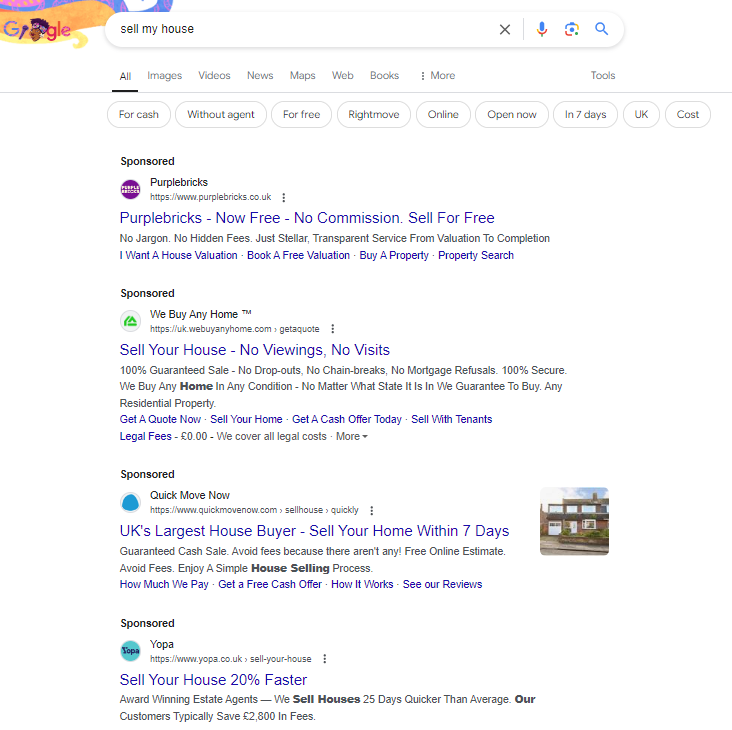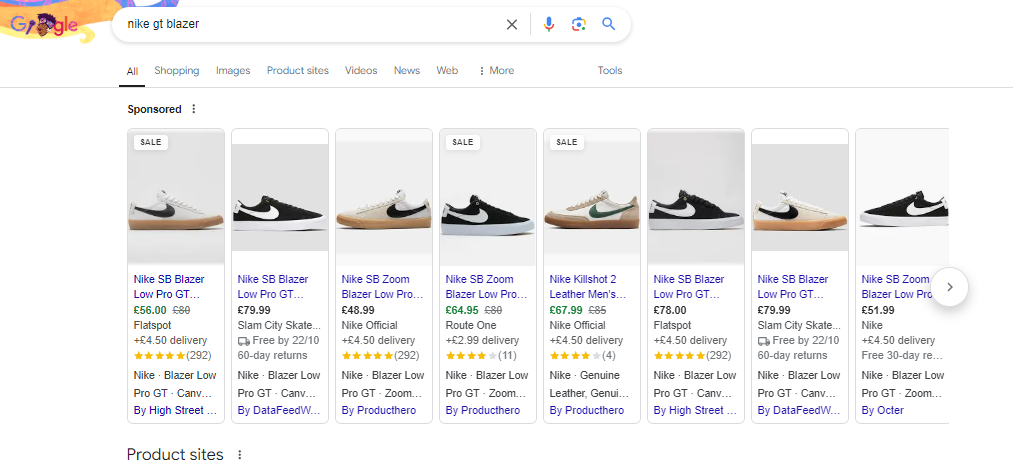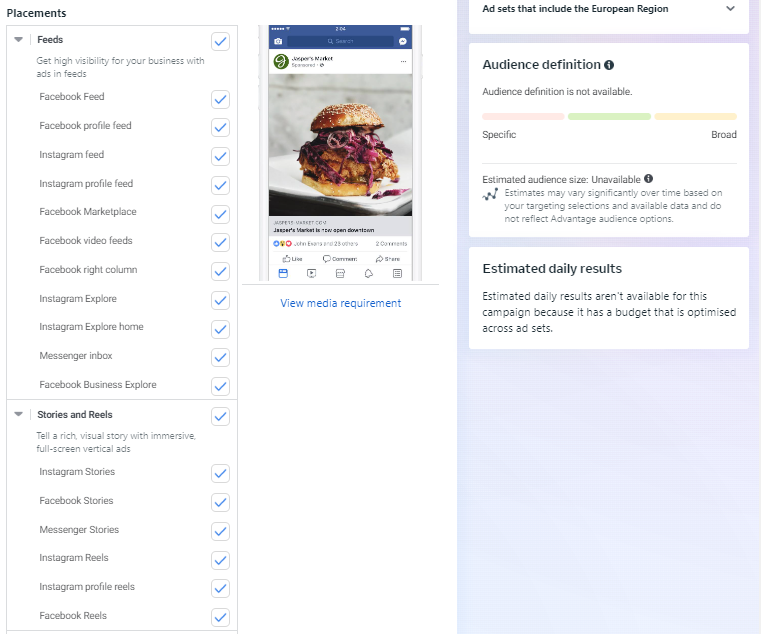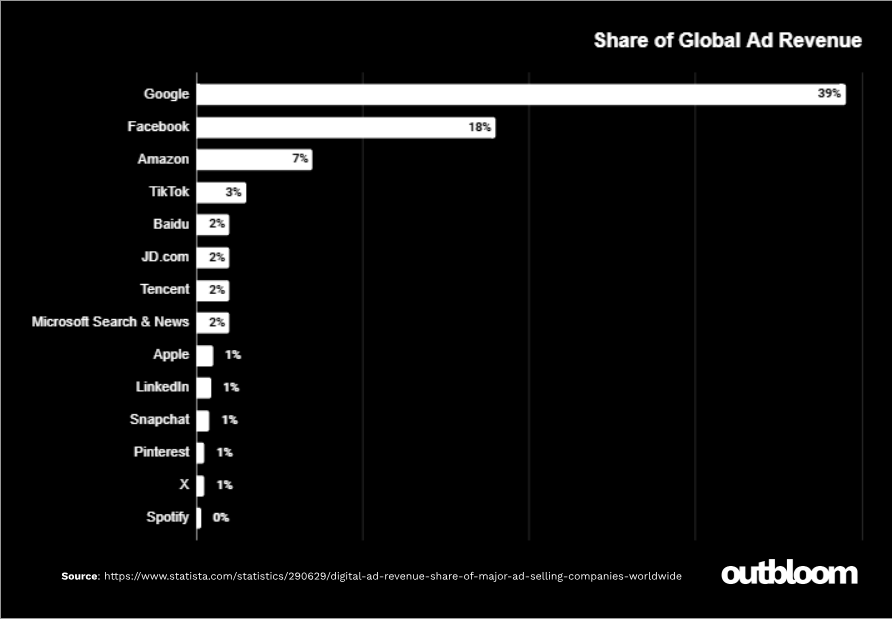Google Ads and Facebook Ads have gone head to head for market share in the Paid Media space over the last two decades.
If you’re a reader of tech media, you’ll have been fed the blurb that these two media giants have been at war to demand the biggest cut of budget from performance and brand marketing teams, positioning them to be direct competitors, which really isn’t the case.
The statement “Google Ads vs Facebook Ads” plays to this storyline, however, the reality couldn’t be further from the truth.
These two platforms have unique functionalities that require different strategies to succeed and when executed well, with the right balance, can drive incredible results.
This post breaks down exactly what Google Ads and Facebook Ads are, how they work, the pros and cons of each platform and answers the question ‘which is better?’
TOPICS COVERED IN THIS POST:
WHAT IS GOOGLE ADS?
Google Ads is made up of many different elements.
This platform provides advertisers the ability to serve ads on the Google Search Results Page (aka SERP), on >35 million websites and apps across Google owned properties, on YouTube, Google Maps, and much more.
Google Ads uses a pay-per-click (PPC) model, meaning that advertisers pay a fee each time one of their ads are clicked, at the very top level, each industry has different cost-per-clicks (aka CPC) based on:
- Competition – The more advertisers bidding on the same keywords the higher the CPC. Industries such as; hotels, banking, restaurants, and groceries are amongst the most competitive, whereas very specific niches may only have a handful of advertisers in the auction.
- Value of Acquiring a Customer – Different industries have different customer lifetime values (aka LTV). Take insurance for example (the industry with the highest CPCs), the cost of acquiring a customer for health insurance is considerably higher than acquiring a new lead for a local dog walking service, but the LTV of a health insurance customer is greater, potentially making the greater acquisition cost worthwhile.
- Search Behaviour – Whatever the industry/vertical, search demand ebbs and flows throughout the weeks, days and even hours. During these periods of fluctuation, there may be higher/lower commercial intent and competitors will likely flex budgets to get the most out their Google Ads spend, which in-turn impacts CPCs.
The most well known element of Google Ads is the Search Network, referred to as Paid Search.
This allows advertisers to build campaigns using keywords (the terms that people are searching for) and serve their ads on the SERP with the goal of enticing a new/returning customer to then click through and land on their website, as such:

Another part of the Search Network is Google Shopping, also a feature of Performance Max (aka PMax) campaigns.
This is where advertisers list their products on Google (SERP and/or partner websites/apps) using a product feed which lives in the Google Merchant Center.
The product feed (and other factors) determine how and when Google serve ads on the SERP through the shopping listings (often referred to as product listings or PLAs), as such:

Whether through keywords on Google Search or product listing ads through Google Shopping, the main goal for these advertising strategies is to drive new or returning customers to a website who are actively searching for products and services.
WHAT IS FACEBOOK ADS?
Facebook Ads is the heart of the paid social industry.
The term ‘paid social’ refers to the practice of advertising on social networks (Facebook, Instagram, TikTok, Pinterest, etc).
Launched in 2004, Facebook (now Meta) has the highest number of monthly active users of any social network and running ads through this platform has become a key priority for many marketing teams.
With surging popularity, competition is sky high and brands are forever testing new strategies to help gain advantage which are often driven by creative.
Unlike Google Ads Search or Google Shopping, Facebook Ads is audience based and there are no keywords/search terms.
Brands reach customers using interests, demographics, first-party data and automated solutions such as lookalike audiences, where users provide Facebook with a seed list (e.g. customer emails) and then allow the platform to find new users with similar characteristics.
Once advertisers have chosen their target audiences, Facebook offers placements in which these ads can be served (Facebook Feed, Instagram Reels, Facebook Marketplace, Messenger, and more) and a wealth of ad formats:

Campaigns work towards various objectives:
- Awareness – Show ads to people who are most likely to remember them
- Traffic – Send people to a destination, such as a website, app, page or event
- Engagement – Generate messages, video views, likes, comments, responses, etc
- Leads – Drive leads directly through the platform or by sending traffic to a website
- App Promotion – Get new user app installs and ensure current users are engaging
- Sales – Find people who are likely purchase your product and/or service
Feeds can also be used as part of a Facebook advertising and a common strategy involves splitting campaigns by new customer acquisition (often referred to as prospecting), retargeting and, brand building.
Facebook Ads performance has a strong reliance on creative as this platform is inherently visual.
Brands who steam ahead and maintain competitive advantage are the ones who seamlessly blend their media together to create compelling assets that drive high engagement to meet their campaign objectives.
With this, comes the cost for creative (whether outsourced or in-house) that does not typically exist when running Google Ads.
Facebook Ads isn’t set-and-forget, brands who cut corners or rarely test/refresh creative will end up worse off in the long-run than those who invest time and effort into delivering the best visuals in line with their end goal.
PROS AND CONS OF GOOGLE ADS
THE PROS
- Quick and Self Serving – In theory, you can create a Google Ads account from scratch and begin serving ads on the SERP within minutes. Compare this to OOH or Connected TV, these channels require planning, negotiations, creative, and more. Google Ads on the other hand can be turned on and off at will, allowing advertisers to appear immediately.
- Intent – There’s two sides to the intent advertisers are able to benefit from using Google Ads. One being Google Search (PPC) where advertisers are able to target keywords and get their ads in front of people at all stages of the marketing funnel, from the very top (e.g. ‘white trainers’) down to the bottom (e.g. “white nike air max mens size 10”). The other being Google Shopping, (product listings), serving visual ads on the SERP based on search terms.
- Tracking and Data – Quantifiable results are given from the moment a campaign launches, this is further enhanced when conversion tracking is implemented to show advertisers which ads, promotions, keywords, and pages are driving the results, and which aren’t.
- Reach – Of the 5.4 billion internet users, 4.97bn of them use Google. Pair this with 8 billion daily searches, the reach of Google Ads is as big as it gets for advertising platforms.
- (Can Be) Scalable – Let’s say your account is performing above target on search and you’ve got a solid foundation in place with available impression share. In this position you can start to scale up; increasing budgets, loosening targets, etc, but as with anything PPC related, there’s a world of context to be considered and not a one size fits all approach, but from a tactical standpoint, scaling Google Ads with the right partner can be fast moving.
THE CONS
- Cost – Dependent on your market, Google Ads can be costly. CPCs have been rising over the last 10 years and the fight to win auctions has become more competitive, the US alone seeing a 9% rise YoY between 2023 and 2024. There isn’t a sweet spot on how much you should be investing in Google Ads, and claims that there is one neglect any contextuality. It’s dependent on available marketing budget, expected returns and the industry you operate in, the balance between these three will determine how long it will take to gather learnings and how much this will cost.
- Your Website (and Business) – Activating a Google Ads campaign is no different to opening the door of a shop and letting customers walk in. Customers may look at items, put in the basket, or, walk straight out. There’s no guarantee that the budget you invest will translate into leads/sales, and we’ve heard this fallacy many times. A brand’s website and actual business (proposition, product, customer service, etc) are the most important element of any Google Ads campaign and should be the number one priority.
- Time and Resource – Google Ads is not set-and-forget, despite the narrative shifting towards fully automated solutions such as PMax. Understanding and interpreting data should be a constant, finding what is working/isn’t working and why, delving into how this can be leveraged to drive the best possible performance.
- Support and Guidance – With Google Ads being self serving and barriers to entry into Google Ads management being non existent, the sheer volume of content and advice available can be overwhelming. Whether it’s an exec looking for advice on a certain campaign feature or a multinational brand deciding which agency to onboard, the market is very saturated and finding experts and thought leaders you can trust is a difficult task.
THE PROS AND CONS OF FACEBOOK ADS
THE PROS
- Self Serving – As with Google Ads, Meta ads are self-serving. Advertisers can create an ad account, build a campaign and start serving ads themselves, without the need for any third parties. This is great in the sense that brands can move quickly and start driving visibility fast, however, without any prior exposure to the ad platform, it can be overwhelming as there’s many different elements that make up a Meta Ads campaign.
- Reach – With over 2 billion daily users on Meta and 500 million on Instagram, the reach available to advertisers is vast. This, combined with the wealth of targeting options make it a great platform to use for all types of advertisers. This could be a small brand is looking to drive footfall for a local store with specific regional restrictions or a global fashion brand wanting to invest millions into conversions based advertising, whatever the goal, Meta has the reach to cater for all budgets.
- Visual – This is where the two platforms differ greatly, when brands talk about Google Ads they are likely referring to the search network (e.g. text ads), whereas Meta and Instagram ads are highly visual and require creative input. This opens the door for brands to showcase their products and services using images, videos, product feeds,
- Targeting – Advertisers can build campaigns to target; demographics, interests, behaviours, locations, email lists, and more. There’s no keywords, and brands reach their users through audiences, a clear difference to Google Ads that must be considered when running Meta and Instagram Ad campaigns.
THE CONS
- Cost – Millions of brands and individuals advertise on Meta, and the competition for ad space is fierce. In 2024, the average CPM in the UK sits between £3.45 and £7.79, the highest of all global markets, and it doesn’t show signs of slowing down. Brands may find a winning combination of audiences, placements, and ads, then over time will likely see costs increase which will impact the bottom line and have an impact on efficiency.
- Competition – There are over 10 million active advertisers using Meta ads, underscoring the effectiveness of this advertising platform. Your target audiences will be inundated with ads across their Meta and Instagram feeds each day and the need to serve genuinely engaging ad content that is always being tested has never been so important.
- Tracking and Attribution – By default, Google Ads conversions use a Data Driven Model, this distributes credit across paid and organic touchpoints to provide an view of performance. Meta is different, the default setting is 7 day click and 1 day view, so if a user clicks on an ad (anywhere on the ad, not just outbound clicks) and within 7 days makes a purchase/sends a lead, Meta will receive the credit. The same applies to 1 day view. A view we often hear is that Meta overestimates performance, which when considering the attribution model, disconnect from other channels/ad networks, and the usage of data modelling, can make it hard for advertisers to trust performance.
- Complexity – Meta ads has hundreds of settings that make up each campaign, from the attribution window to placements, multi-advertiser ads, and ad enhancements. Getting to grips with how each element works and how to build out, manage, and optimise campaigns can be a daunting task for advertisers who’ve not had exposure to this platform prior.
GOOGLE ADS VS FACEBOOK ADS
It isn’t a case of one over another, they are very different.
The reason why this is frequently discussed is due to the market share these two companies dominate, which translates into where brands are spending their marketing budget:

Each platform has strengths, weaknesses and offer different solutions to suit all types of advertisers.
They compliment each other and harnessing the power of both is a proven advertising strategy, as long as advertisers understand how best to use each platform to get the very best results.
You have to consider the funnel and where your strategies sit.
Take Google Search for example, you are able to serve ads in auctions using keywords, allowing brands to invest heavily at the bottom of the funnel.
Whereas on Meta, if you were solely going after direct new customer sales using interest based audiences, you’re not going to get the same results as you’re serving ads to cohorts of users in the millions who likely won’t be directly looking for your product/service.
Whatever platform or strategy you are using, always ensure you have expert advice on how to execute a winning campaign, which in this industry can be difficult to find with the platforms being self-serving.
Anyone can set up a Facebook business center or Google MCC and start looking to manage other brands’ budgets, which is a scary thought, and the main reason we built outbloom.
WHICH IS BETTER?
To put it bluntly, one isn’t better than the other.
They serve very different purposes and cater to advertisers of all sizes across almost every industry.
This likely isn’t the answer you were looking for, but it is the truth.
Once you think about the two in silo, it will provide a much clearer view of how to get the most out of these advertising platforms to drive the best results for your business.
THE QUESTIONS WE GET ASKED MOST
- Are facebook ads cheaper than Google Ads? It completely depends on the context. Benchmarking the CPM for Google Search or Display against the Instagram CPM wouldn’t be an accurate comparison.
- Should you use Facebook Ads or Google Ads? What is your goal and how are you going to achieve it? Once you have this, you can slot each platform into various stages of the funnel based on the capabilities they have.
- What is the difference between Google Ads and Facebook Ads? Click here for the breakdown.
- Does Facebook Ads have a better Conversion Rate than Google Ads? Context dependent and should be evaluated on a case-by-case basis.
- Does Google Ads have a better Conversion Rate than Facebook Ads? See above ↑
- Is Google Ads better for B2B vs Facebook Ads? As with all points, context is needed, however, to answer this question, ask yourself “what type of business are we?” and “where are our target customers spending time?”.


